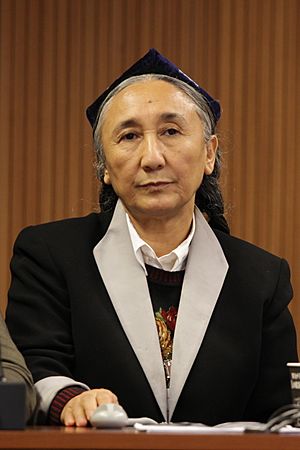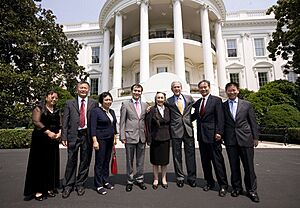Rebiya Kadeer facts for kids
Quick facts for kids
Rebiya Kadeer
|
|
|---|---|
| رابىيە قادىر 热比娅·卡德尔 |
|

Kadeer in 2012
|
|
| 2nd President of the World Uyghur Congress |
|
| In office 27 November 2006 – 12 November 2017 |
|
| Preceded by | Erkin Alptekin |
| Succeeded by | Dolkun Isa |
| President of the Uyghur American Association | |
| In office 2006–2011 |
|
| Member of the 8th Chinese People's Political Consultative Conference | |
| In office March 1993 – March 1998 |
|
| Personal details | |
| Born | 15 November 1946 Altay City, Altay Prefecture, Xinjiang, China |
| Political party | |
| Spouses | Abdurehim Tohti (m. 1962, div. 1977), Sidik Haji Rozi (m. 1981) |
| Children | 6 (with Abdurehim Tohti), 5 (with Sidik Rozi) |
| Residences | Virginia, United States |
| Occupation | Political activist |
| Known for | Former President of the World Uyghur Congress (2006.11 – 2017.11) Nobel Peace Prize Nominee (5 times) |
| Website | World Uyghur Congress website |
Rebiya Kadeer (Uyghur: رابىيە قادىر, romanized: Rabiye Qadir; born 15 November 1946) is a businesswoman and activist from the Uyghur ethnic group in China. She was born in Altay City, Xinjiang, China. In the 1980s, Kadeer became very wealthy through her real estate and a large business group. She held important roles in Chinese political groups. Later, she became a leader for Uyghur organizations outside of China, like the World Uyghur Congress.
Contents
Early Life and Business Success
Rebiya Kadeer was born in Altay City in Xinjiang. When she was young, she moved with her family to Wensu County. In 1962, she married her first husband, Abdurehim Tohti.
Family Background
According to her book, Dragon Fighter: One Woman's Epic Struggle for Peace with China, Rebiya Kadeer's family had moved to Gulja. Her grandparents came from different areas of Xinjiang. Her father had been involved with Uyghur groups that fought against the government in the 1940s. Kadeer's family was also friends with some Russian people living in Xinjiang.
Starting a Business
Rebiya Kadeer had six children with her first husband. To help her family, she started making and selling clothes and other small items. This was a challenge during the Cultural Revolution in China. She faced difficulties because of her business activities.
After her first marriage ended, Kadeer opened a laundry service in 1976. In 1981, she married Sidik Haji Rouzi. They moved to Ürümqi and had five children together.
Becoming a Millionaire
After the Soviet Union ended, Kadeer started trading goods across borders. She became very successful and earned a lot of money, becoming one of the richest people in China. People called her "the millionairess." Her trading company worked in China, Russia, and Kazakhstan.
Kadeer also started the Akida Industry and Trade Co. This company owned many buildings in Xinjiang, including the Akida Trade Center. She used her wealth to help her community. She created the 1,000 Mothers Movement. This charity helped Uyghur women start their own businesses. It also supported Uyghur children who were in need.
Role in Chinese Politics
For a time, Rebiya Kadeer worked with the Chinese government. She was chosen to be a delegate for important political meetings. She also attended a United Nations conference for women in Beijing in 1995. Kadeer was a member of the Chinese Communist Party before she was removed. She also held leadership roles in business and women's groups in Xinjiang.
Kadeer helped organize aid for people affected by the 1997 Jiashi earthquakes. These earthquakes caused a lot of damage and destroyed many homes.
Activism and Later Life
In 1996, Rebiya Kadeer's husband, Sidiq Rouzi, moved to the United States. He worked for radio stations that broadcast news about China. Kadeer faced problems because she did not speak out against her husband's activities. She was not chosen for political roles again in 1998.
Kadeer was arrested in 1999. She was accused of sharing information with her husband. She was found guilty of breaking laws about state secrets. While she was in prison, she received the Rafto Prize for human rights. This award brought international attention to her situation.
Release and Move to the U.S.
On 14 March 2005, Kadeer was released from prison early. She was allowed to go to the United States for health reasons. The U.S. had asked for her release. On 17 March, Kadeer flew to the U.S. and joined her family.
In November 2006, she became the president of the World Uyghur Congress. This group works for the rights of Uyghur people. She also became president of the Uyghur American Association. After her release, some of her children faced legal issues in China.
The Chinese government has described Kadeer as a "separatist." In 2007, Kadeer met with President George W. Bush in Prague. Bush praised people like Kadeer for their talent and importance to their nations. In September 2007, the United States House of Representatives asked the Chinese government to release Kadeer's children.
Events in 2009
In July 2009, there were protests and riots in Ürümqi. The Chinese government claimed that the World Uyghur Congress, led by Kadeer, had planned these events. Kadeer denied these accusations.
In September 2009, Taiwan did not allow Kadeer to visit. They said she had links to a group considered a terrorist organization. Kadeer denied these claims. Chinese state media reported that two of Kadeer's children wrote letters blaming her for the riots. The World Uyghur Congress said these letters were not real.
Also in 2009, a documentary film called The 10 Conditions of Love was made about Kadeer. When the film was shown at a festival in Australia, there were protests from the Chinese consulate. The festival's website was also attacked by hackers. The film was also planned to be shown in Taiwan.
Views on Uyghur Independence
In 2011, Rebiya Kadeer said that the Chinese government might be trying to divide the Uyghur people. She believes that movements for independence have less support from other countries. She stated that Uyghur people were not happy under Chinese rule.
Seeking Support from Japan
In May 2012, Kadeer visited Tokyo, Japan. She asked the Japanese government to talk to China about human rights issues. She also visited a shrine and said she hoped to create a similar place for Uyghur heroes in the future.
Works
- with Cavelius, Alexandra (2008). Die Himmelsstürmerin: Chinas Staatsfeindin Nr. 1 erzählt aus ihrem Leben. Heyne. ISBN: 978-3-453-64041-2. (German)
- English edition: Dragon Fighter: One Woman's Epic Struggle for Peace with China. W. W. Norton & Company, Inc. ISBN: 978-0-9798456-1-1.
See also
 In Spanish: Rebiya Kadeer para niños
In Spanish: Rebiya Kadeer para niños
- Rushan Abbas
- Uyghur Americans
- Uyghur American Association


